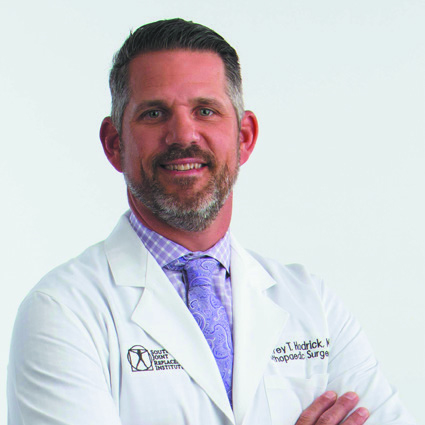
Robotics Delivering Innovation, Better Outcomes in Joint Replacement at TriStar Centennial
Robotics has revolutionized surgery in 2021, with few specialties impacted quite like orthopaedics. More than two decades since the first robotic-assisted surgery, joint replacement surgeons have embraced the latest techniques delivering unprecedented precision and improved patient outcomes – often in an outpatient setting.
Changing the Paradigm
Despite robotics’ proven track record, Jeffrey Hodrick, MD, orthopaedic surgeon at TriStar Centennial’s Advanced Joint Replacement Institute, said patients are still sometimes hesitant about robotics in the operating room. “While this is semi-automated, where I control the robotic arm, there is still some misunderstanding around what the robot does,” he explained. “I see the robotic arm as an extension of me, and the robot makes me a better surgeon.” Hodrick tells patients the robot allows him to plan and perform the surgery at a level of precision that has never been available before. “While the robot helps eliminate outliers, it does more. It allows me to focus on the most important aspect of knee replacement: balance,” he said.
Improved Precision
The use of robotics in any industry revolves around precision, and joint replacement – particularly knees – is no exception. “When performing knee replacement, you’re focused on alignment and balancing of the soft tissues around the knee,” said Hodrick, who’s performed more than 750 robotic knee replacements at AJRI. “Robotics helps to quantify those measurements, and then execute that plan.” The robotic arm cuts bone within a tenth of a degree and within a tenth of a millimeter. The software allows for enhanced 3D preoperative planning, custom templated sizing, while respecting the patient’s individual anatomy and deformity. “We can make changes to the plan based on the patient’s soft tissues in a virtual environment, before cutting any bone. Surgeons love to plan and don’t like surprises,” Hodrick said.
Creating Balance
While knee replacement is statistically a highly successful operation, there are still a small percentage of patients who are not completely satisfied. “Often times they don’t require another operation, but they’re just not as happy as they thought they’d be,” Hodrick said. While a small subset have underlying conditions like depression or anxiety, known to increase susceptibility to pain, less than satisfactory outcomes are often related to instability in their knee replacement. “Ideally, you have the same amount of ligament tension on the inside and outside of the knee,” Hodrick explained. “If you can balance the knee so that the ligaments have the same amount of tension through range of motion, the patient has a better chance of feeling good and having an excellent outcome. It’s quite complicated, but having a pre-operative plan, and being able to adjust that plan in a virtual environment while marrying soft tissue information with planned bone cuts from pre-operative CT scans, all help to better balance the knee in the OR and create a better result.”
Experience Matters
Surgeon experience also plays a big role in patient satisfaction. “Patients need to understand the level of training and experience a surgeon has, and ask how many replacements the surgeon has performed,” he said. “There’s a lot of research that shows the more joint replacements you perform, the better you are.” At SJRI, Hodrick is one of six fellowship trained joint replacement surgeons. They work with designated, specially trained OR staff on a floor specifically designed for joint replacement patients. “Every staff member who comes in contact with our patients are joint replacement specialists in their own area. We are proud to deliver that level of expertise,” said Hodrick. He participates in research and trains fellows on the latest techniques including robotic knee, outpatient surgery and rapid recovery – another buzzword for surgeons in 2021. “Surgical recovery is shortening all the time, with a strong trend toward outpatient surgery,” he said. “It’s pretty amazing to think about.” Shorter recovery times are due partially to advanced surgical techniques that require less soft tissue to be released during robotic-assisted procedures. He also credits advances in pain control, with spinal anesthesia often combined with a regional or local injection around the incision. SJRI surgeons also are committed to limiting opioid use, knowing the side effects can be worse than the discomfort itself. “What we’re learning is that patients can better engage in physical therapy, so they can return to work and become independent faster,” he said. “I have the best job in the world, because I can offer patients a surgery that reliably relieves pain. That’s extremely gratifying.”